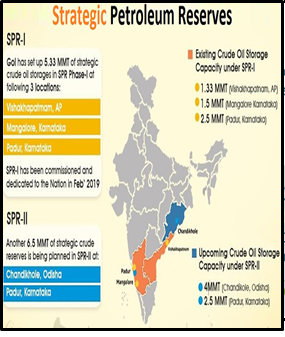INDIA PLANS NEW 15-20 MILLION TONNE OIL RESERVE IN MANGALORE
Why in the news?
India’s strategic oil reserve expansion aims to enhance energy security and support its bid for full membership in the International Energy Agency, amid global oil market volatility.
source:scribd
Project Overview:
- Feasibility Study: The Indian Strategic Petroleum Reserves Ltd (ISPRL) is assessing the feasibility of a new strategic reserve in Mangalore with a planned capacity of 15-20 million tonnes.
- Cost & Timeline: Estimated project cost is ₹5,000 crore. The feasibility study is expected to be completed by September 2024. If results are positive, the proposal will be submitted to the Union Cabinet for approval.
- Current Capacity: Mangalore currently has a 1.5 million-tonne reserve as part of ISPRL’s existing 5.33 million-tonne storage capacity.
Expansion Plans:
- Phase-II Expansion: Includes additional reserves at Padur, Karnataka (2.5 million tonnes) and Chan- dikhol, Odisha (4 million tonnes). Bids for the Padur reserve are expected to be opened this month, while land acquisition for the Chandikhol site is nearing completion.
| About Strategic Petroleum Reserves in India:
Overview: Managed by Indian Strategic Petroleum Reserves Limited (ISPRL), a subsidiary of the Oil Industry Development Board, under the Ministry of Petroleum & Natural Gas. Current Reserves (Phase I):
Expansion Plans (Phase II):
Storage and Supply:
Objective:
key Government Initiatives in Oil and Gas Sector: Fiscal Incentives:
LPG Infrastructure Investment:
Natural Gas Trading Exchange:
Bio-CNG Plants:
|




